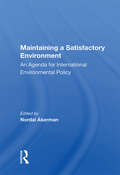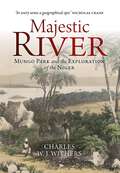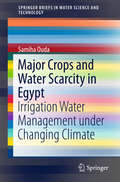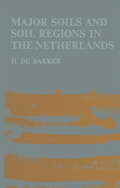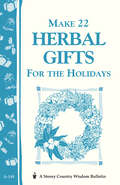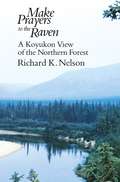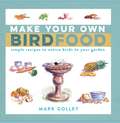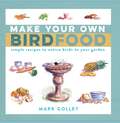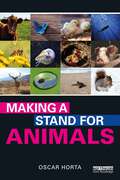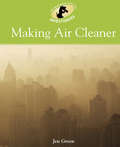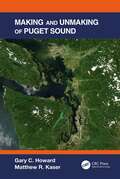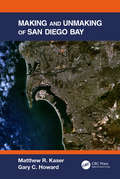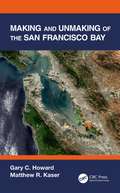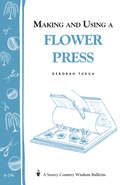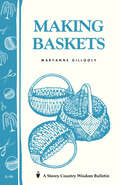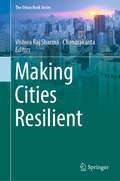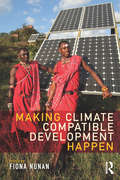- Table View
- List View
Maintaining A Satisfactory Environment: An Agenda For International Environmental Policy
by Nordal ÅkermanThis book is an outcome of a seminar organized to discuss an agenda for saving the environment of Europe. It covers the issues in international environmental policy and explores how to achieve an integration of environmental policies with other governmental policies and through economic instruments.
Majestic River: Mungo Park and the Exploration of the Niger
by Charles W. WithersOne of the greatest stories of world exploration ever told. By the late eighteenth century, the river Niger was a 2,000-year-old two-part geographical problem. Solving it would advance European knowledge of Africa, provide a route to commercial opportunity and help eradicate the evil of slavery. Mungo Park achieved lasting fame in 1796 by solving the first part of the Niger problem – which way did the river run? Park died in 1806, in circumstances which are still uncertain, in failing to solve the second – where did the Niger end? Numerous expeditions explored the river in the decades following Park’s death, but not until 1830 was its final course revealed following in-the-field exploration. By then, however, the Niger problem had been solved by ‘armchair geographers’ who had never even visited Africa. Majestic River celebrates Mungo Park's achievements and illuminates his rich afterlife – how and why he was commemorated long after his death. It is also the thrilling story of the many expeditions that sought to determine the Niger’s course and the facts of Park’s disappearance, as well as a biography of the Niger itself as the river slowly took shape in the European imagination.
Major Crops and Water Scarcity in Egypt: Irrigation Water Management under Changing Climate (SpringerBriefs in Water Science and Technology)
by Samiha OudaThis book includes multi-disciplinary quantifications of the effect of climate change on water requirements of wheat, maize, rice and sugarcane. Furthermore, it provides on-farm management that faces water scarcity under current situation and under climate change. Changing cultivation method (raised beds instead of furrows or basins) or increasing irrigation application efficiency (sprinkler or drip systems instead of surface irrigation) can reduce the applied water. Irrigated agriculture, although profitable, it endures wasteful use of valuable water resources. Taking into account the risk of climate change, developing countries like Egypt will highly suffer. Furthermore, the effect of intercropping (two crops use the applied water to one of them), and/or using crop rotations (arrange crops to reduce the applied water, increase water productivity and sustain soil fertility) on production and consumed irrigation water by crops were comprehensively analyzed.
Major soils and soil regions in the Netherlands
by H. de BakkerSoil science in the Netherlands puts strong emphasis on the relationship between parent material and soil formation, and between physiographic conditions and land use. This approach, developed by the late Professor Dr C. H. Edelman ( 1903-1964), is quite understandable in a country where soils have to a great extent developed from alluvial and aeolian materials of recent geological origin. Dutch soil scientists have paid much attention to pedogenesis in fresh sediments, known as 'initial soil formation' or 'ripening', and to groundwater as a soil forming factor. Furthermore, human influence on soil genesis, in this land of man-made soils, has been tho roughly investigated. 'Major soils and soil regions in the Netherlands' clearly reflects these specific features of soils work in this country. In his book, Mr H. de Bakker, Head of the Soil Classification Section of the Netherlands Soil Survey Institute (Stichting voor Bodemkartering) addresses the special interests of foreign soil scientists and of students of earth sciences. The author examines representative soil profiles not only with respect to the Netherlands' system of soil classification- of which he is the co-author-but also in terms of some of the major classification systems used in other countries. It appears that a well characterized soil profile may find a very different place in various classifications and that even for a trained specialist it is often difficult to arrive at a specific determination within a given system.
Make 22 Herbal Gifts for the Holidays: Storey's Country Wisdom Bulletin A-149 (Storey Country Wisdom Bulletin)
by Editors of Garden Way PublishingSince 1973, Storey's Country Wisdom Bulletins have offered practical, hands-on instructions designed to help readers master dozens of country living skills quickly and easily. There are now more than 170 titles in this series, and their remarkable popularity reflects the common desire of country and city dwellers alike to cultivate personal independence in everyday life.
Make Prayers to the Raven: A Koyukon View of the Northern Forest
by Richard K. Nelson"Nelson spent a year among the Koyukon people of western Alaska, studying their intimate relationship with animals and the land. His chronicle of that visit represents a thorough and elegant account of the mystical connection between Native Americans and the natural world."—Outside "This admirable reflection on the natural history of the Koyukon River drainage in Alaska is founded on knowledge the author gained as a student of the Koyukon culture, indigenous to that region. He presents these Athapascan views of the land—principally of its animals and Koyukon relationships with those creatures—together with a measured account of his own experiences and doubts. . . . For someone in search of a native American expression of 'ecology' and natural history, I can think of no better place to begin than with this work."—Barry Lopez, Orion Nature Quarterly "Far from being a romantic attempt to pass on the spiritual lore of Native Americans for a quick fix by others, this is a very serious ethnographic study of some Alaskan Indians in the Northern Forest area. . . . He has painstakingly regarded their views of earth, sky, water, mammals and every creeping thing that creepeth upon the earth. He does admire their love of nature and spirit. Those who see the world through his eyes using their eyes will likely come away with new respect for the boreal forest and those who live with it and in it, not against it."—The Christian Century "In Make Prayers to the Raven Nelson reveals to us the Koyukon beliefs and attitudes toward the fauna that surround them in their forested habitat close to the lower Yukon. . . . Nelson's presentation also gives rich insights into the Koyukon subsistence cycle through the year and into the hardships of life in this northern region. The book is written with both brain and heart. . . . This book represents a landmark: never before has the integration of American Indians with their environment been so well spelled out."—Ake Hultkrantz, Journal of Forest History
Make Prayers to the Raven: A Koyukon View of the Northern Forest
by Richard K. Nelson"Nelson spent a year among the Koyukon people of western Alaska, studying their intimate relationship with animals and the land. His chronicle of that visit represents a thorough and elegant account of the mystical connection between Native Americans and the natural world."—Outside "This admirable reflection on the natural history of the Koyukon River drainage in Alaska is founded on knowledge the author gained as a student of the Koyukon culture, indigenous to that region. He presents these Athapascan views of the land—principally of its animals and Koyukon relationships with those creatures—together with a measured account of his own experiences and doubts. . . . For someone in search of a native American expression of 'ecology' and natural history, I can think of no better place to begin than with this work."—Barry Lopez, Orion Nature Quarterly "Far from being a romantic attempt to pass on the spiritual lore of Native Americans for a quick fix by others, this is a very serious ethnographic study of some Alaskan Indians in the Northern Forest area. . . . He has painstakingly regarded their views of earth, sky, water, mammals and every creeping thing that creepeth upon the earth. He does admire their love of nature and spirit. Those who see the world through his eyes using their eyes will likely come away with new respect for the boreal forest and those who live with it and in it, not against it."—The Christian Century "In Make Prayers to the Raven Nelson reveals to us the Koyukon beliefs and attitudes toward the fauna that surround them in their forested habitat close to the lower Yukon. . . . Nelson's presentation also gives rich insights into the Koyukon subsistence cycle through the year and into the hardships of life in this northern region. The book is written with both brain and heart. . . . This book represents a landmark: never before has the integration of American Indians with their environment been so well spelled out."—Ake Hultkrantz, Journal of Forest History
Make Prayers to the Raven: A Koyukon View of the Northern Forest
by Richard K. Nelson"Nelson spent a year among the Koyukon people of western Alaska, studying their intimate relationship with animals and the land. His chronicle of that visit represents a thorough and elegant account of the mystical connection between Native Americans and the natural world."—Outside "This admirable reflection on the natural history of the Koyukon River drainage in Alaska is founded on knowledge the author gained as a student of the Koyukon culture, indigenous to that region. He presents these Athapascan views of the land—principally of its animals and Koyukon relationships with those creatures—together with a measured account of his own experiences and doubts. . . . For someone in search of a native American expression of 'ecology' and natural history, I can think of no better place to begin than with this work."—Barry Lopez, Orion Nature Quarterly "Far from being a romantic attempt to pass on the spiritual lore of Native Americans for a quick fix by others, this is a very serious ethnographic study of some Alaskan Indians in the Northern Forest area. . . . He has painstakingly regarded their views of earth, sky, water, mammals and every creeping thing that creepeth upon the earth. He does admire their love of nature and spirit. Those who see the world through his eyes using their eyes will likely come away with new respect for the boreal forest and those who live with it and in it, not against it."—The Christian Century "In Make Prayers to the Raven Nelson reveals to us the Koyukon beliefs and attitudes toward the fauna that surround them in their forested habitat close to the lower Yukon. . . . Nelson's presentation also gives rich insights into the Koyukon subsistence cycle through the year and into the hardships of life in this northern region. The book is written with both brain and heart. . . . This book represents a landmark: never before has the integration of American Indians with their environment been so well spelled out."—Ake Hultkrantz, Journal of Forest History
Make Prayers to the Raven: A Koyukon View of the Northern Forest
by Richard K. Nelson"Nelson spent a year among the Koyukon people of western Alaska, studying their intimate relationship with animals and the land. His chronicle of that visit represents a thorough and elegant account of the mystical connection between Native Americans and the natural world."—Outside "This admirable reflection on the natural history of the Koyukon River drainage in Alaska is founded on knowledge the author gained as a student of the Koyukon culture, indigenous to that region. He presents these Athapascan views of the land—principally of its animals and Koyukon relationships with those creatures—together with a measured account of his own experiences and doubts. . . . For someone in search of a native American expression of 'ecology' and natural history, I can think of no better place to begin than with this work."—Barry Lopez, Orion Nature Quarterly "Far from being a romantic attempt to pass on the spiritual lore of Native Americans for a quick fix by others, this is a very serious ethnographic study of some Alaskan Indians in the Northern Forest area. . . . He has painstakingly regarded their views of earth, sky, water, mammals and every creeping thing that creepeth upon the earth. He does admire their love of nature and spirit. Those who see the world through his eyes using their eyes will likely come away with new respect for the boreal forest and those who live with it and in it, not against it."—The Christian Century "In Make Prayers to the Raven Nelson reveals to us the Koyukon beliefs and attitudes toward the fauna that surround them in their forested habitat close to the lower Yukon. . . . Nelson's presentation also gives rich insights into the Koyukon subsistence cycle through the year and into the hardships of life in this northern region. The book is written with both brain and heart. . . . This book represents a landmark: never before has the integration of American Indians with their environment been so well spelled out."—Ake Hultkrantz, Journal of Forest History
Make Your Own Bird Food: Simple Recipes to Entice Birds to Your Garden
by Mark GolleyBirds are the life and soul of any garden, whatever its size or location, and one thing can be guaranteed: if food is on offer, birds will visit.With this in mind, Make Your Own Bird Food brings you some of the most popular and successful bird food recipes ever served up, ensuring your bird feeder or table will be the toast of avian gourmet for years to come.With 40 quick, easy and cheap meal ideas and a range of useful cookery tips and helpful hints on what to feed and when, it won't be long before you'll have birds flocking to your garden.
Make Your Own Bird Food: Simple Recipes to Entice Birds to Your Garden
by Mark GolleyBirds are the life and soul of any garden, whatever its size or location, and one thing can be guaranteed: if food is on offer, birds will visit.With this in mind, Make Your Own Bird Food brings you some of the most popular and successful bird food recipes ever served up, ensuring your bird feeder or table will be the toast of avian gourmet for years to come.With 40 quick, easy and cheap meal ideas and a range of useful cookery tips and helpful hints on what to feed and when, it won't be long before you'll have birds flocking to your garden.
Making a Stand for Animals
by Oscar HortaEngaging and thought-provoking, this book examines how humans see and treat other animals and argues that we should extend equal consideration and respect to all beings, human and nonhuman alike. Our world is plighted by ‘isms’ such as racism and sexism, but we may have overlooked a very important one: speciesism. Speciesism is a form of discrimination against those who don’t belong to a certain species. It drives us to see nonhuman animals as objects, rather than individuals with their own interests and with the ability to feel and suffer. This book questions all of the assumptions speciesism is based upon. It raises many challenging questions over humans' very complicated attitudes toward other animals. Thinking about how animals are used as well as the suffering of wild animals, and what the future may be for all beings, this book calls for society to seriously take into account the interests of all animals. For all who care about animals, or simply how to make the world a better place, this book is essential reading.
Making a Stand for Animals
by Oscar HortaEngaging and thought-provoking, this book examines how humans see and treat other animals and argues that we should extend equal consideration and respect to all beings, human and nonhuman alike. Our world is plighted by ‘isms’ such as racism and sexism, but we may have overlooked a very important one: speciesism. Speciesism is a form of discrimination against those who don’t belong to a certain species. It drives us to see nonhuman animals as objects, rather than individuals with their own interests and with the ability to feel and suffer. This book questions all of the assumptions speciesism is based upon. It raises many challenging questions over humans' very complicated attitudes toward other animals. Thinking about how animals are used as well as the suffering of wild animals, and what the future may be for all beings, this book calls for society to seriously take into account the interests of all animals. For all who care about animals, or simply how to make the world a better place, this book is essential reading.
Making Air Cleaner: Making Air Cleaner (Environment Detective Investigates #3)
by Jen GreenWhy is clean air important?How do people cause air pollution?How is air pollution affecting Earth's climate?The Environment Detective Investigates helps you to answer these questions and many more about making air cleaner. Find out what causes air pollution, what is being done to tackle air pollution and how we can help make the air cleaner.
Making and Unmaking of Puget Sound
by Gary C. Howard Matthew R. KaserThe Puget Sound is a complex fjord-estuary system in Washington State that is connected to the Pacific Ocean by the Juan de Fuca Strait and surrounded by several large population centers. The watershed is enormous, covering nearly 43,000 square kilometers with thousands of rivers and streams. Geological forces, volcanos, Ice Ages, and changes in sea levels make the Sound a biologically dynamic and fascinating environment, as well as a productive ecosystem. Human activity has also influenced the Sound. Humans built several major cities, such as Seattle and Tacoma, have dramatically affected the Puget Sound. This book describes the natural history and evolution of Puget Sound over the last 100 million years through the present and into the future. Key Features Summarizes a complex geological, geographical, and ecological history Reviews how the Puget Sound has changed and will likely change in the future Examines the different roles of various drivers of the Sound’s ecosystem function Includes the role of humans—both first people and modern populations. Explores Puget Sound as an example of general bay ecological and environmental issues
Making and Unmaking of Puget Sound
by Gary C. Howard Matthew R. KaserThe Puget Sound is a complex fjord-estuary system in Washington State that is connected to the Pacific Ocean by the Juan de Fuca Strait and surrounded by several large population centers. The watershed is enormous, covering nearly 43,000 square kilometers with thousands of rivers and streams. Geological forces, volcanos, Ice Ages, and changes in sea levels make the Sound a biologically dynamic and fascinating environment, as well as a productive ecosystem. Human activity has also influenced the Sound. Humans built several major cities, such as Seattle and Tacoma, have dramatically affected the Puget Sound. This book describes the natural history and evolution of Puget Sound over the last 100 million years through the present and into the future. Key Features Summarizes a complex geological, geographical, and ecological history Reviews how the Puget Sound has changed and will likely change in the future Examines the different roles of various drivers of the Sound’s ecosystem function Includes the role of humans—both first people and modern populations. Explores Puget Sound as an example of general bay ecological and environmental issues
Making and Unmaking of San Diego Bay
by Matthew R. Kaser Gary C. HowardSan Diego Bay is a shallow estuary surrounded by a large population center. Geological forces and changes in sea levels from the last Ice Age combine to make the Bay and the adjacent highlands and mesas. Human activity has also influenced the Bay. Humans built several major cities and filled significant parts of the Bay. This book describes the natural history and evolution of the San Diego Bay Area over the last 50 million years through the present and into the future. Key Features Summarizes a complex geological, geographical, and ecological history Reviews how the San Diego Bay has changed and will likely change in the future Examines the different roles of various drivers of Bay ecosystem function Includes the role of humans—both first people and modern populations—on the Bay Explores San Diego Bay as an example of general bay ecological and environmental issues Related Titles Howard GC and Kaser MR. Making and Unmaking of the San Francisco Bay (ISBN 9781138596726) Wang Y, ed. Remote Sensing of Coastal Environments (ISBN 978-1-1381-1638-2) Gonenc IE, Wolfin JB, eds. Coastal Lagoons: Ecosystem Processes and Modeling for Sustainable Use and Development (ISBN 978-0-3675-7814-5) Mossop E, ed. Sustainable Coastal Design and Planning (ISBN 978-0-3675-7075-0)
Making and Unmaking of San Diego Bay
by Matthew R. Kaser Gary C. HowardSan Diego Bay is a shallow estuary surrounded by a large population center. Geological forces and changes in sea levels from the last Ice Age combine to make the Bay and the adjacent highlands and mesas. Human activity has also influenced the Bay. Humans built several major cities and filled significant parts of the Bay. This book describes the natural history and evolution of the San Diego Bay Area over the last 50 million years through the present and into the future. Key Features Summarizes a complex geological, geographical, and ecological history Reviews how the San Diego Bay has changed and will likely change in the future Examines the different roles of various drivers of Bay ecosystem function Includes the role of humans—both first people and modern populations—on the Bay Explores San Diego Bay as an example of general bay ecological and environmental issues Related Titles Howard GC and Kaser MR. Making and Unmaking of the San Francisco Bay (ISBN 9781138596726) Wang Y, ed. Remote Sensing of Coastal Environments (ISBN 978-1-1381-1638-2) Gonenc IE, Wolfin JB, eds. Coastal Lagoons: Ecosystem Processes and Modeling for Sustainable Use and Development (ISBN 978-0-3675-7814-5) Mossop E, ed. Sustainable Coastal Design and Planning (ISBN 978-0-3675-7075-0)
Making and Unmaking of the San Francisco Bay
by Gary C. Howard Matthew R. KaserSan Francisco Bay is a shallow estuary surrounded by a large population center. The forces that built it began with plate tectonics and involved the collision of the Pacific and North American plates and the subduction of the Juan de Fuka plate. Changes in the climate resulting from the last ice age yielded lower and then higher sea levels. Human activity influenced the Bay. Gold mining during the California gold rush sent masses of slit into the Bay. Humans have also built several major cities and filled significant parts of the Bay. This book describes the natural history and evolution of the SF Bay Area over the last 50 million years through the present and into the future. Key selling features: Summarizes a complex geological, geographical and ecological history Reviews how the San Francisco Bay has changed and will likely change in the future Examines the different roles and various drivers of Bay ecosystem function Includes the role of humans - both first peoples and modern populations - on the Bay Explores San Francisco Bay as an example of general bay ecolgical and environmental issues
Making and Unmaking of the San Francisco Bay
by Gary C. Howard Matthew R. KaserSan Francisco Bay is a shallow estuary surrounded by a large population center. The forces that built it began with plate tectonics and involved the collision of the Pacific and North American plates and the subduction of the Juan de Fuka plate. Changes in the climate resulting from the last ice age yielded lower and then higher sea levels. Human activity influenced the Bay. Gold mining during the California gold rush sent masses of slit into the Bay. Humans have also built several major cities and filled significant parts of the Bay. This book describes the natural history and evolution of the SF Bay Area over the last 50 million years through the present and into the future. Key selling features: Summarizes a complex geological, geographical and ecological history Reviews how the San Francisco Bay has changed and will likely change in the future Examines the different roles and various drivers of Bay ecosystem function Includes the role of humans - both first peoples and modern populations - on the Bay Explores San Francisco Bay as an example of general bay ecolgical and environmental issues
Making and Using a Flower Press: Storey's Country Wisdom Bulletin A-196 (Storey Country Wisdom Bulletin)
by Deborah TukuaSince 1973, Storey's Country Wisdom Bulletins have offered practical, hands-on instructions designed to help readers master dozens of country living skills quickly and easily. There are now more than 170 titles in this series, and their remarkable popularity reflects the common desire of country and city dwellers alike to cultivate personal independence in everyday life.
Making Baskets: Storey's Country Wisdom Bulletin A-96 (Storey Country Wisdom Bulletin)
by Maryanne GilloolySince 1973, Storey's Country Wisdom Bulletins have offered practical, hands-on instructions designed to help readers master dozens of country living skills quickly and easily. There are now more than 170 titles in this series, and their remarkable popularity reflects the common desire of country and city dwellers alike to cultivate personal independence in everyday life.
Making Birdhouses: Easy and Advanced Projects
by Leon H. Baxter Gladstone CaliffThis practical guide for building birdhouses contains plans for more than fifty attractive and useful structures — from a one-room house for bluebirds to a forty-two-room structure for purple martins. In addition to instructions and diagrams for constructing houses for such avian varieties as robins, wrens and chickadees, the easy-to-follow text also provides suggestions for feeding devices, bird house materials, methods of finishing exteriors, and winter care for birds. An authoritative, how-to book that will appeal to beginning and veteran woodcrafters alike, Making Birdhouses also features a supplement with easy projects for novices — among them simple structures for woodpeckers, a box for robins, and an “A-frame” for nuthatches. Plans for houses made from such common objects as gourds, a flower pot, tin cans, and an old lantern are also included.Detailed instructions and diagrams assure successful completion of projects that will satisfy builders as well as their feathered friends.
Making Cities Resilient (The Urban Book Series)
by Vishwa Raj Sharma ChandrakantaAs the world has transformed, so have cities. Today, cities are home to 54 percent of the world’s population, and by the middle of this century that figure will likely rise to 66 percent. According to the United Nations (UN) Habitat I (1972), Habitat II (1996) and Habitat III (2016) summits, cities are facing many serious challenges, including growing inequality, security concerns and the worsening impacts of climate change. Uncontrolled urbanization has led to many problems (haphazard growth of areas, emergence of slums, inadequate water and power supply, poor sanitation, shortage of transport and other civic amenities, shrinking green spaces, pollution, crime, and urban disaster risks such as fire, flood, road and industrial accidents, etc.). Worldwide, communities at the international, national and local level are continuously working to improve human habitats. In order to make our planet more sustainable, the UN has moved from the Millennium Development Goals (MDG) to the Sustainable Development Goals (SDG). Among the latter, the aim of SDG 11 is to “…make cities and human settlements inclusive, safe, resilient and sustainable.” In light of these challenges, various terms have emerged to help understand urban issues. Visualizing the problem, the United Nations program “Making Cities Resilient” is focused on mitigating the disaster risk in urban areas. This book analyzes terms such as: sustainable, resilient, livable, inclusive, smart and world class city, which have emerged in the process of combating urban challenges in today’s world. The book addresses emerging concepts for cities, challenges and potentials, urban environments, health and planning/policies. Covering 14 large cities in India, as well as case studies from Japan, Singapore, Thailand, Malaysia, Poland and Sweden, it provides a regional dimension to and micro-level perspective on urban issues.
Making Climate Compatible Development Happen
by Fiona NunanMaking Climate Compatible Development Happen introduces readers to the concept of climate compatible development (CCD) through exploring what it might look like, how it could be achieved in practice and identifying challenges and dilemmas raised by CCD. The book brings together research that explores the assumptions underlying CCD and applies the concept in a range of geographic and sectoral settings. The volume makes a significant contribution to the theorisation and evidence-base for how development efforts can be made more climate resilient and with lower greenhouse gas emissions than a ‘business as usual’ approach. It provides critical reflections on the vision and conceptualisation of CCD, exploring how to encourage it, and what trade-offs and challenges may be encountered. The contributions discuss the feasibility of achieving CCD, mechanisms that may support progress towards it, challenges that may be experienced and the roles of, and impacts on, different stakeholder groups. Following a critical reflection on the concept of CCD, the potential nature of, and barriers to, CCD, it is examined in relation to agriculture, renewable energy, forestry, pastoralism, coastal areas and fisheries, with case studies taken from countries including Ghana, India, Kenya, Mongolia, Mozambique and Peru. The book provides a valuable cross-sectoral and international critical reflection on the theory and practice of CCD, and will be a resource for postgraduates, established scholars and undergraduates from any social science discipline, policymakers and practitioners studying or working on areas related to the interface between environment (climate change) and international development.
